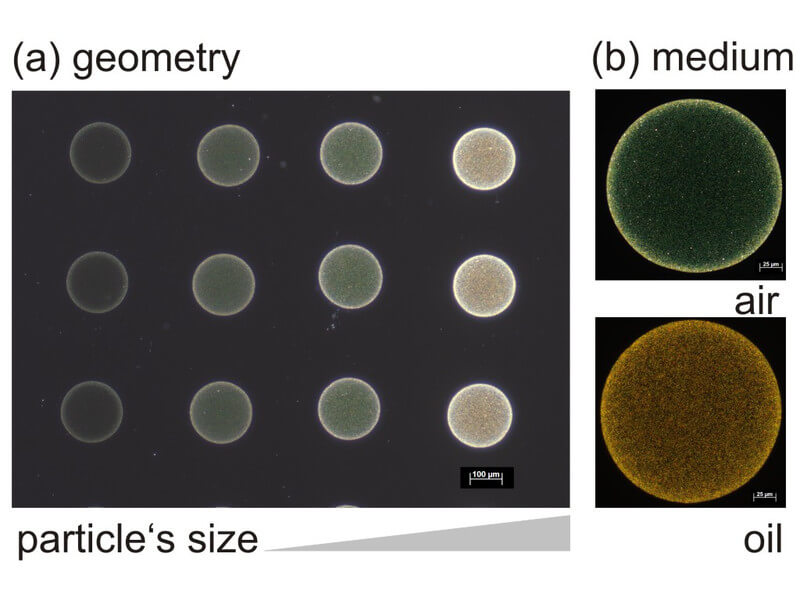- Home
- Research
- Nanobiophotonics
- Research results
- Plasmonic Biosensing
Plasmonic Biosensing

28.03.2019
Metallic nanostructures can be effectively used as an optical transducer for biomolecular sensors. We developed a method how nanostructured chips employed for the sensing can be elegantly fabricated in very flexible and cost-efficient way of piezo-dispensing of chemically prepared colloidal nanoparticles. This development can bring the plasmonic technology step closer to practical use.
Von O. Stranik // D. Zopf // W. Fritzsche // A. Csaki
An elegant way of bio-molecule detection is based on the effect of localised surface plasmon resonance occurring in metallic nanoparticles. Metallic nanoparticles have the nice property that they have the ability to strongly interact with light. They act as small nano-resonators, which scatter/absorb incoming light at specific wavelengths. Moreover, these nano-resonators are very sensitive to their local environment. Therefore, adsorption of molecules can be traced just by spectroscopic analysis of the nanoparticle’s optical response. The key-lock principle, practically done by attachment of complementary molecules on the nanoparticles, ensures the molecular specificity of the detection. Such general detection schema can be applied for many different relevant bio-markers such as DNA, proteins and drugs.
The development of plasmonic biosensors is rapidly progressing in recent years with accelerating tendency. We critically reviewed this progress in the recent publication [1] and identified the most promising concept, together with an estimation of future advances. The huge commercial potential for plasmonic sensors is underlined by the fact that there are already more than ten companies offering products based on this emerging technology. The application spans over pathogen and cancer diagnostics, food/environmental analytics, autoimmune diseases and immunodiagnostics. This diversity of the application is only possible through the development of techniques for binding of different receptors, such as antibody, aptamers, oligonucleotides, bacteriophages, peptides and saccharides on the surface of the particles.
However, in order to be commercially successful in plasmonic biosensing, high quality and disposable plasmonic substrates fabrication has to be accomplished. Up to date, top-down approaches for fabrication of nanostructured surfaces are still relative expensive. The alternative way, which is a chemical synthesis of nanostructures, is much more cost efficient, but produces the nanostructures usually in a suspension. A challenging step for this method is the deposition of the colloidal nanoparticles on a substrate in a controlled manner. We showed in our recent publication [2] that this is possible by piezo-dispensing technique and that such fabricated nanostructured substrates are viable for plasmonic sensing.
The piezo-dispensing technique is a fast and flexible method for deposition of sub nano liter volumes of solution on substrates with high precision and is usually used to create microarrays of proteins or other relevant molecules. We employed this technique to dispense different types of nanoparticle solutions, and combined it with a chemical surface modification in order to produce homogenous attachment of the nanoparticles on the substrate. It was very important to avoid the aggregation of the particles on a substrate during the drying process of droplets; otherwise it would change the plasmonic response of the particles, and therefore, prevent using these spots for the plasmonic sensing. After optimizing several parameters, we were able to create patterns of spots with different plasmonic properties very reproducibly. Figure 1a shows a microscopic dark-field image of an array of 120 micrometer diameter spots consisting of thousands of gold nanoparticle with each column having different size of the particles. The spots exhibit high degree of reproducibility, and their color is dictated by the plasmonic properties of the individual deposited particles. Figure 2b demonstrates the sensing principle of such fabricated plasmonic spots. Bare nanoparticles scatter green color, but when they are covered by a layer of higher refractive index (oil) then the color change to yellow. We hyper-spectral imaged such nanostructured microarrays and showed that they have very small spectral variation (standard deviation less than 1 nm) and that each individual spots can be used as an independent sensor. The bio-sensing ability of these arrays was successfully demonstrated for the detection of small proteins.
Funded by: EU EraNET/ BMBF RA-Detekt, RAPID
